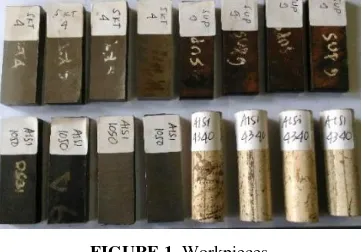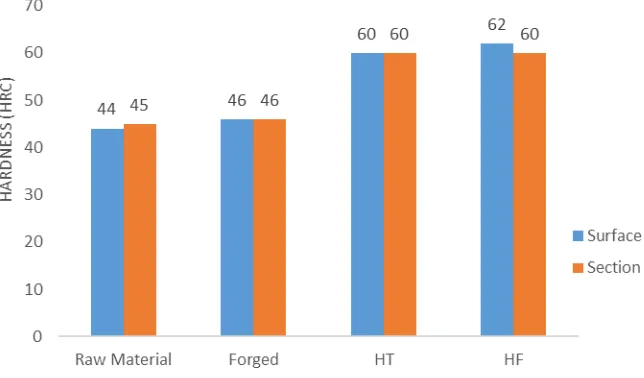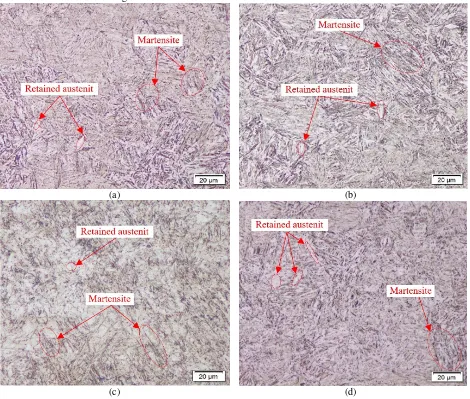Effect of Raw Materials and Hardening Process on
Hardness of Manually Forged Knife
Balkhaya
1,a), Suwarno
1,b)1Mechanical Engineering Department, Institut Teknologi Sepuluh Nopember Surabaya (ITS), Surabaya 60111, Indonesia,
Abstract. Knives is normally made by forging process either using a machine or traditional method by means of hammering process. This present work was conducted to study the effects of steel raw materials and hardening process on hardness of manually forged knives. The knife samples were made by traditional hammering (forging) process done by local blacksmith. Afterward, the samples were heat treated with two different hardening procedure, the first was following the blacksmith procedure and the second was systematically done in the laboratory. The forging was done in the temperature ranged between 900-950°C, while the final temperature ranged between 650-675oC. The results showed that knives made of spring steel and heat treated in simulated conditions in the laboratory have highest hardness, i.e. 62 HRC. In average knives heat treated by local blacksmith have lower hardness that those of hardened in simulated condition. Therefore, we concluded that traditional knife quality especially the hardness can be improved by optimizing the heat treatment schedule.
INTRODUCTION
There are many kinds of cutting devices in machinery and food processing equipment. The quality of the cutting component depends on the material characteristics and its production method. A cutting device has the same function with a knife. They have the sharpness on the cutting side and though on the core. The manufacturing process of blades from steel bar, ingot, or plate is typically done by forging [4]. Traditionally, a blacksmith uses manual forging to make a knife. Commonly knives produced by traditional blacksmiths have poor quality, i.e. soft and blunt. There are two common methods to make the traditional blade, i.e. pattern welding and Damascus method [2][6]. The pattern welding process consists of forge two dissimilar steels to have a combined properties of the blade. While the Damascus method forges a single bar of steel with engineered composition [1]. On the hardness level a damsacus blade has a better sharpness than blade made of alloy steel of AISI 52100 or AISI 1086 [3]. Theoretically knife’s quality which produced by blacksmith can be improved with right material choice, good manufacturing process, and perfect finishing process. In this work, we study the traditional forging method done by a local blacksmith to make a knife from the various composition of the steel. Our goal is to know the process parameter to control the hardness of the blades.
RESEARCH METHODOLOGY AND MATERIALS
TABEL 1. Chemical composition of materials.
The geometries of raw materials were in the form of thick plate or cylinder. Before the forging process the raw material were cut as shown in Fig. 1. For the plate, the dimensions were 70 mm in length, 30 mm in width and 10 mm in thickness. While for the bar, the dimensions were 20 mm in diameter and 6,8 mm in length.
FIGURE 1. Workpieces
Traditional Knife Forging Process
During the forging process, the workpieces were heated in traditional blacksmith’s furnace. The workpieces were heated to 950oC as measured by infrared thermocouple. The sample was traditionally forged until the temperature is dropped to 650oC. Each heating process is was followed by repeated hammering process ranged between 32 to 39 times for every 5 cm length of the sample in which one cycle hammering took about 28-35 seconds. Cycles of heating and forging process as shown in Fig. 2 were repeated to shape a knife. This was followed by a grinding process to flatten the knife’s surface and to form the knife’s cutting edge.
The hardening process were done with two schedule, i.e. traditional way following the black smith method and in simulated condition in laboratory. The traditional heat treatment method was done by heating the sample in a homemade like furnace as shown in Fig. 3a until 850oC for 10 minutes and quenched the sample in water. Simulated heat treatment was done by heating the sample in laboratory type furnace at 850oC for 60 minutes and hold at that temperature for 30 minutes followed by quenching in water.
(a)
(b)
FIGURE 3. Type of furnaces used in the experiment: (a) traditional furnace. (b) modern furnace (electric)
Hardness Measurement
Hardness measurements were done in surface and cross-section of the knife. Before the test is performed, the knife was cut to 10 mm in width as shown in fig. 4a. The length and the thickness remain the same as the dimension of the knife.
(a) (b)
FIGURE 4. The specimen of knives. (a) Hardness test specimen. (b) Mounted specimen
The sample was mounted in polymer as shown in FIGURE 4b to ease the measurement. Then, the specimens were grinded with 80, 120, and 220 grid paper. The hardness test was performed using a Rockwell C hardness test machine. This test machine uses a diamond indentor with the 120o angle and 150 Kp load.
Microstructure Observation
Microstructure observation was performed in a mounted sample. The specimen was prepared by grinding with SiC papers and followed by polishing with alumina powder. The SiC paper used for grinding were with size of 80, 120, 220, 400, 600, 800, 1000, 1200, 1500 and 2000 grid. The etching process were done in natal. The observed sections are the surface, and the sharp edge of the knife.
RESULT AND DISCUSSIONS
Hardness Test Results
FIGURE 5. Hardness of knives made of AISI 1050 before and after different heat treatment schedule.
The initial hardness difference between the inner section and the surface hardness is 27 and 28 HRC. Post forging hardness for the surface section is 31 HRC and the post forging hardness for the inner section is 30 HRC. The hardness point escalates more after the hardening process to 56 HRC for a surface section and 55 HRC for the inner section (HT). While in furnace hardening process (HF) the hardness point increased to 58 HRC in surface section and 57 HRC in inner section.
FIGURE 6. Hardness Graphic of AISI 4340 steel’s knife
FIGURE7. Hardness Graphic of JIS SKT 4 steel’s knife
Figure 7 shows the test results for JIS SKT 4 steel. Contrary to the previous materials, the JIS SKT 4 initial hardness difference between the inner section and the surface hardness is 52 and 48 HRC. The inner section is harder than the surface section. Post forging hardness for the surface section is 53 HRC and the post forging hardness for an inner section is 54 HRC. Post-hardening-surface-hardness for both HT and HF is 61 HRC while the post-hardening-inner section-hardness is 58 HRC for HT method and 60 HRC for HF method.
FIGURE 8. Hardness Graphic for spring steel’s knife
Figure 8 represents the hardness point of spring steel specimen. The initial hardness is 44 HRC in surface section and 45 HRC in inner section. forging-hardness is 46 HRC in both surface and inner section. Post-hardening-hardness also yield the same result for both surface and an inner section which are 60 HRC for HT method and 62 HRC for HF method.
The overall test results show that the process of forging in high-temperature conditions led to an increase in hardness. The increased hardness also happened in the inner section of the knife due to grain deformation inflicted by forging force which caused grain dislocation. The grain dislocation due to forging force is causing the strain hardening effect to the material and thus, increase the hardness point.
HF process produce better hardness point compared to HT thanks to the even heating in HF process. The hardness results in both hardening process HT and HF shows that there is significant hardness escalation. This is due to austenite transformation to martensite during the cooling process. Austenite transformation to martensite is a diffusionless transformation so that leaves the austenite and martensite composition equal. The formation of martensite is due to entrapped carbon in the grain boundary of austenite structure due to quenching process. This leads to diffusion less transformation of Fe so that the austenite unable to transform to pearlite due to lack of time. These whole phenomena lead to an escalation in hardness point for each knife’s material.
AISI 4340 steel (59 HRC, Fig. 6) and AISI 1050 steel (58 HRC, Fig. 5). These differences are caused by the differences in carbon content in each material Table 1. The higher the carbon content, the better the hardenability for each material. Cr, Mo, Mn and Mo also contributing to a material’s hardness.
The hardness of martensite structure due to quenching depends on the carbon content. The atom carbons are considered to transform the crystal structure from FCC (austenite) to BCT (martensite). The C solubility in BCC is increased if martensite was formed, one of the thing that caused the BCT structure to formed Fig 9. The higher the carbon composition in the material the more interstitial position excluded so that the probability for a BCT structure to form is even greater.
(a) (b)
(c) (d)
FIGURE 9. HF-processed-knife microstructure. (a) AISI 1050 steel. (b) AISI 4340 steel. (c) JIS SKT4 steel (d) Spring Steel
Figure 9 shows the formed structure after hardening process. Martensite structure is quite like needles and fine plate (dark) which is more dominant compared to retained austenite structure (bright). This leads to the escalation in hardness after hardening process in knives material.
CONCLUSIONS
The high-temperature-manual-forging process increased the hardness of knives of each material. The hardness was increased further after different treatment. The highest hardness was obtained in spring steel with hardening furnace (HF) method about 62 HRC and the lowest hardness was obtained in AISI 1050 steel with traditional hardening (HT) approximately 55 HRC. Hardening process done in the produces optimum hardness all knives. Therefore, hardening process employed by blacksmith can be optimized further to increase the quality of knives.
REFERENCES
1. Fatollahi, F., Fard, Damascus Steel, MSE, Vol. 121, hal 1-10 (2011)
2. zkan, F., Kirdan, H., Kara, I. H., H sem, F., Akinay, Y., Ug, H. C., Sun, Y., Ahlatic, H, Mechanical Propertis of pattern welding 1075-15N20 Steel. Mater test. Vol. 56, Hal. 897-900 (2014).
3. Verhoeven, J.D., Pendra, A.H., Clark., H.F., Wear tests of steel knife blades. Wear. Vol. 265, Hal. 1093-1099 (2008).
4. Verhoeven, J.D, The Mystery of Damascus Blades. Scientific American. Vol, 284, No.1, Hal. 74-79 (2001).
5. Verhoeven, J.D Metallurgy of Steel for Bladesmiths & Others who Heat Treat and Forge Steel, Profesor emeritus, Iowa State University, march 2005




